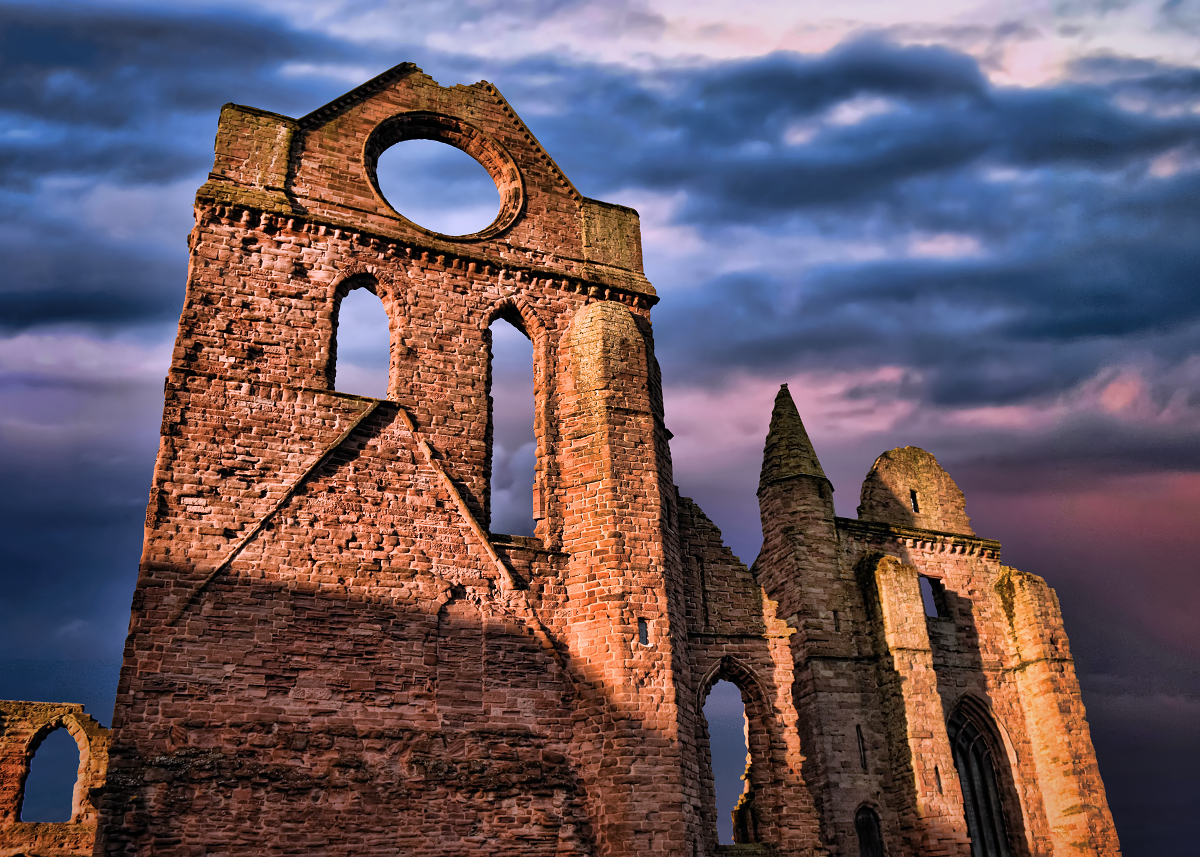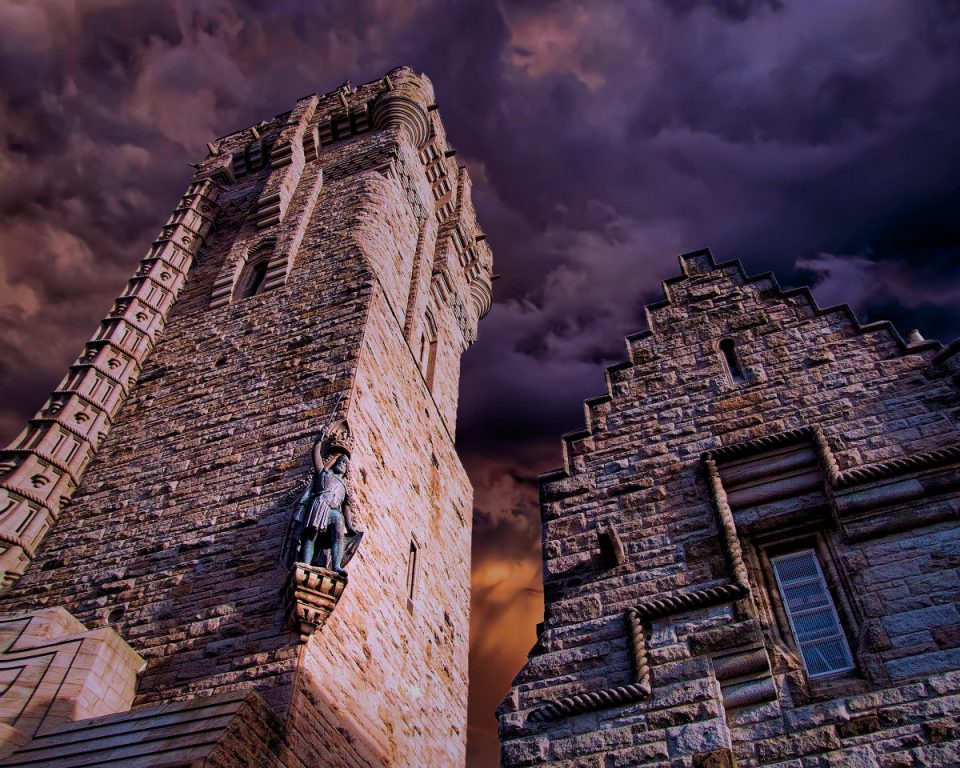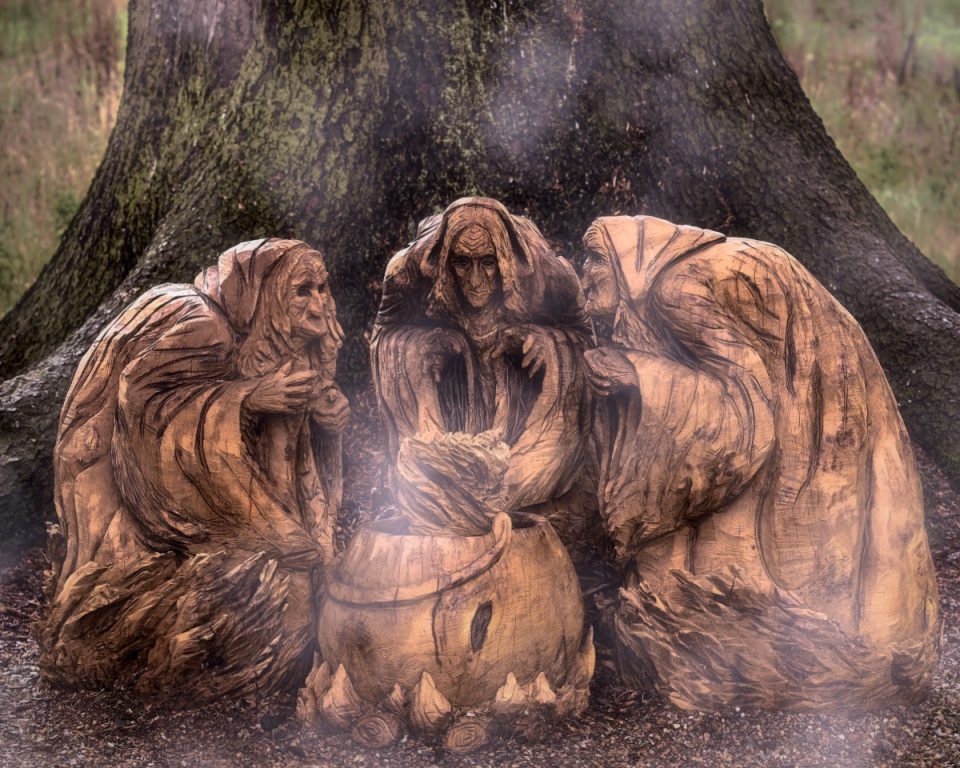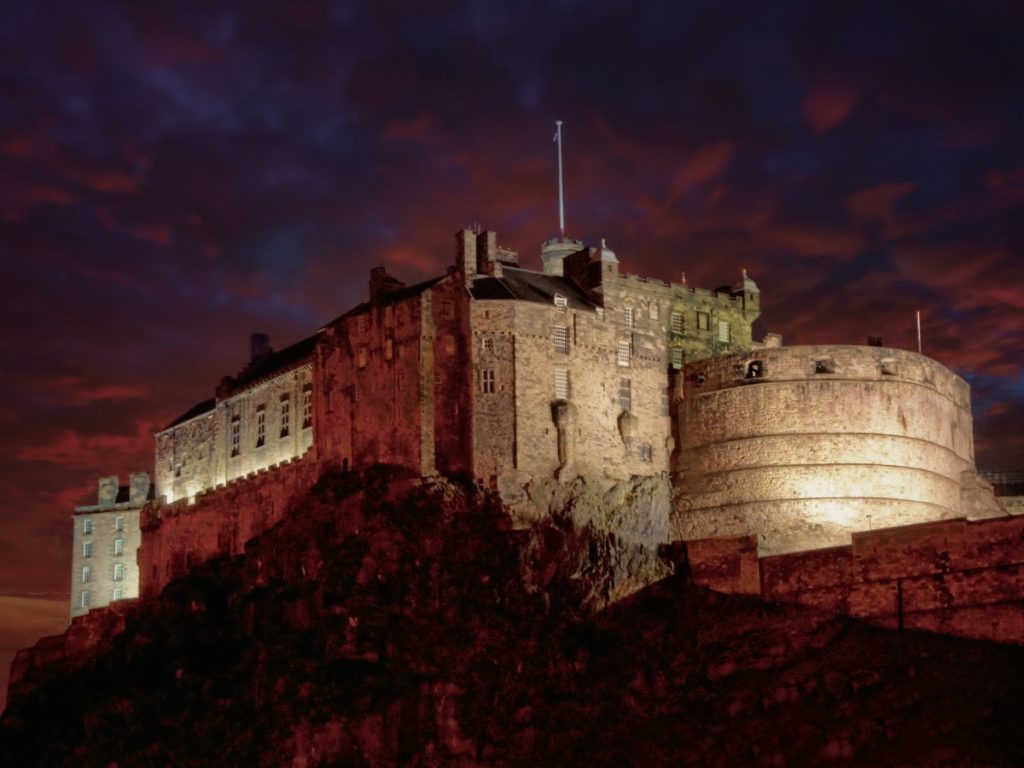On the 11th April 1951, Scotland’s Stone of Destiny was found on the High Altar of Arbroath Abbey. The Stone had been missing for months. Some would argue that the Stone had not really been stolen for the Stone had been wrested from Scotland some seven hundred years before. But how can a simple block of stone capture the hearts of a people? Why is this Stone held in such high regard?
Scotland’s Pictish stones have some of the most intricately designed patterns of their time. But this is no ornate stone. The Stone of Destiny is a mere block of Perthshire red sandstone. It has a rough cross incised on one surface and iron rings at either side for transporting it.
But perhaps like the stone which once held Excalibur, Scotland’s Stone of Destiny is the stuff of legends. Shrouded in myth and mystery, the Stone is said to have magical properties which were once used to identify those who were truly worthy to hold the title King of Scots. Prophecies have been attached to it. Visions have been dreamt upon it. Kings have been crowned upon it. Laws have been decreed from it. Governments have used it as a bargaining chip. It carries with it the remembrance of how a nation rose up to thwart a King who stole the Stone as spoils of war. It brings with it the promise of independence and freedom. Some have sought to possess it. Some have sought to hide it. No-one knows for sure if it is the original stone. Most of all it is the symbol of Scotland’s Sovereignty.
A Stone of Many Names
The Stone of Destiny is known by many names. In England, it is simply known as the Coronation Stone. This is a very serviceable name given its role in the crowning of English and British monarchs over the last 700 years.
It is also known as the Stone of Scone (pronounced Scoon) because this was its final location before it was taken from Scotland.
For the people in Scotland, the Stone was more than just a place for a King to be crowned. Indeed, the original Kings of Scotland were not even crowned at their inauguration ceremonies. Most Kings in Europe succeeded to their thrones using the patrilinear system of Primogeniture. This meant that a King was succeeded by his oldest surviving son. It implied that Kings had a divine right to the throne and were not accountable to their people.
In Scotland and Ireland, another system was followed. This was known as Tanistry. A Tanist or heir was chosen or elected by the people from amongst the King’s male relatives. This was supposed to be the King’s worthiest successor. Thus, the Kingdom could be handed down from a King to his brother and then to his son, possibly even a younger son. However, the King had to be of full age, in possession of all his faculties and without remarkable blemish of mind or body.
According to lore, the Stone of Destiny would know who the rightful king was and would roar with joy when he stepped upon it. Thus, the Stone of Destiny had many other names. In Gaelic it was known as An Lia Fiall (The Stone of the ‘Speaking’). Another Gaelic name is Clach-na-Cinneamhain (The Stone of Descent). It is also referred to as the Tanist Stone.
Origins of the Stone of Destiny
Part of the appeal and mystique of the Stone of Destiny is its unknown origin. The tales of how the Stone arrived in Scotland are diverse and often contradictory. According to ancient legend, the Stone has its origins in the Holy Land. It was used by the Biblical figure, Jacob as a pillow. While he slept, he dreamt of a ladder reaching to Heaven upon which angels could ascend and descend. According to Jewish Tradition, Jacob’s Pillar was used for the pedestal for the Ark of the Covenant in Solomon’s Temple.
However, in Scottish lore, the ‘Jacob’s Pillow’ became the Stone of Destiny. Some have theorised that one of the Lost Tribes of Israel carried it to Scotland. In another story, the legend of the Stone of Destiny goes back to the foundation myth of Scotland. Around 1400 BC, an Egyptian Pharoah had a daughter named Scota who married a greek named Goídel Glas (the alleged creator of the Gaelic language). They were exiled from Egypt and eventually settled in Spain. Their descendants later conquered Ireland around 700 BC. They carried with them a block of sandstone and set it up on the Hill of Tara where the kings of Ireland were crowned. Later they became the Scotti tribe, who went on to form the Scottish Kingdom of Dal Riata. They carried the stone with them to Dunadd, the Capital of Dal Riata.
About 840 AD it was taken by Kenneth McAlpine to the village of Scone.
Political Spin?
However, the origins of this tale may have developed during the Scottish Wars of Independence as political spin. The Scots needed to justify their position as an independent country to the Church and get the Pope’s blessing if they had any hope of survival. After all, the Catholic Church was all-powerful during Medieval times and frequently took on the dual role of king Maker and King Breaker.
History frequently was written long after events took place. The early chroniclers added to the lore. In an account written in the fourteenth century, The Stone was dredged up off the coast of Ireland. In some recounts, Fergus, son of Ferchard was the first King over Dal Riata. He took the Stone from Ireland and had it moved to Dunadd. Later it was moved to Dunstaffnage.
Meanwhile, in other recounts, St Columba used it in the Coronation of King Aedan at Iona. At this point, he Christianised the Ceremony. It is also reputed to be Columba’s death pillow. In one account written in 1527, the Stone was made of marble leading people to speculate that the stone was made from a band of Lewisian marble which can be found on the Isle of Iona. Of course, that implies that the original Stone of Destiny was swapped and that the current stone is a fake.
The Stone of Destiny as The Scottish Coronation Stone
Scone near Perth had become the place of coronation for the ancient Pictish royalty with Dunadd, Dunstaffnage and Iona being the places of inauguration for the Scottish royalty of Dal Riata at various times. In the dim mists of time, there is a sense that these ceremonies would have been pagan and performed by Druids.
Then there was a sudden power switch in Scotland. Viking raiders wiped out much of the Pictish and Gaelic Royalty and Kenneth MacAlpine stepped into the breach. By this time both Pict and Gael were firmly Christian and overseen by the Celtic Church. There is evidence that a Culdee Settlement existed at Scone and was later replaced by an abbey.
With the permanent takeover of Pictland by the Gaelic Kings of Dal Riata, Kenneth MacAlpine was said to have brought the Stone of Destiny with him. However, the written history of the time is scant and frequently inaccurate. Perhaps the Stone of Destiny was Pictish in origin, especially if the Stone, now housed in Edinburgh, is the original. Kenneth’s claim to the throne may have been tenuous and once more political spin came into play. If the Stone of Destiny was Gaelic rather than Pictish, who in the coming ages could question the right of the House of Alpin to the throne of a united Scotland? Interestingly, Ireland also has a Stone of Destiny used anciently to crown its Kings and in their lore, it was said to have come from Scotland.
Genealogies Recited as Part of the Coronation
So, in time the ceremony of inaugurating the Kings of Scots became an amalgamation of ancient Gaelic and Pictish ceremonies mingled with a Christian investiture ceremony. We know that those of the House of Alpin were crowned at Scone upon the Stone of Destiny. A central part of the ceremony involved the King’s Chief Poet, the Ollamh Ríg Alban, reciting the ancestral pedigree of the King, stretching back to the quasi-history of Scota and Goidel Glas.
In historian John of Fordun’s writings, the boy King Alexander III was set upon the Stone of Destiny which ‘was decked with silken cloths inwoven with gold’ and that this was considered to be Scotland’s Coronation throne.
Alas, after Alexander III, only one other Scottish King was crowned upon the Stone of Destiny at Scone. He was John Balliol.
The Stone of Destiny as Spoils of War
The Scottish nobility turned on John Balliol, whom they considered to be a weak and ineffectual king, a mere puppet in the hands of Edward Longshanks. Edward I of England grabbed this opportunity to invade Scotland thus beginning the Scottish Wars of Independence. He stripped Scotland of all emblems of nationhood in 1296 including her sacred Stone of Destiny. Men such as William Wallace and Robert the Bruce rose and defended their country against this tyranny. The invading armies were eventually defeated but alas Scotland’s greatest treasure and heritage were lost, seemingly forever.
Edward took the Stone to London and gave it a new home in Westminster Abbey. A special chair, the ‘Coronation Chair’ was built to house the Stone by Walter of Durham between 1297 and 1300. Edward II was the first English monarch to be crowned here. Every English King was crowned upon it thereafter.
Was it the Westminster Stone a fake?
However, according to legend, as Edward I approached the palace, the monks of Scone quickly removed the Stone of Destiny and hid it replacing it with a stone of a similar shape and size. It was this fake stone which Edward carried back to London. It would explain why the stone is so geologically similar to the sandstone around Scone.
Interestingly, a letter to the editor of the Morning Chronicle, dated 2 January 1819, states that workmen at the West Mains of Dunsinane House, a place said to have connections with Macbeth, uncovered a vault. Within the vault, they discovered among the ruins a large stone, which was ‘pronounced to be of the meteoric or semi-metallic kind.’ Two round bronze tablets were found next to it. On one of these, two lines were engraved, which when deciphered, read ‘The sconce (or shadow) of kingdom come, until Sylphs in air carry me again to Bethel.’ The finders believed it to be ‘Jacob’s Pillow’, the Stone of Destiny and had the Stone shipped to London for analysis.
The Prophecy
The mysteries and legends attached to the Stone of Destiny are endless. Allegedly there was a piece of metal attached to the stone in ancient times. According to Sir Walter Scott, the following prophecy was engraved on the metal plate:
Unless the fates be faulty grown
And prophet’s voice be vain
Where’er is found this sacred stone
The Scottish race shall reign.
When Queen Elizabeth I died without issue in 1603, she was succeeded by King James VI of Scotland. James was crowned James I of England on the Stone of Scone. The patriotic Scots said that the prophecy had been fulfilled for once again a Scotsman ruled where the Stone of Destiny was.
The stone remained at Westminster for almost seven hundred years. During World War II the Stone was secretly buried underneath Westminster Abbey for safekeeping. A plan for locating it was sent to the Canadian prime minister. It remained unscathed from German bombs.
The Stone of Destiny Stolen
It may have seemed that the Stone of Destiny was a permanent fixture at Westminster Abbey, but the Independence Movement was beginning to take hold in Scotland. The Stone was a symbol of Scotland’s Sovereignty. A group of students from Glasgow University set out to remind the Scottish people of their sacred Stone. Ian Hamilton, Gavin Vernon, Kay Matheson and Alan Stuart got together and planned out their daring heist. In the early morning of Christmas Day 1950, the students broke into the Abbey. In attempting to remove the stone from the Coronation Chair, it fell and a corner broke off.
However, it has been speculated that the initial damage was done some thirty-six years earlier. A group of Suffragettes targeted the Stone of Destiny and the Coronation Chair to protest on behalf of women’s rights. The exploded bomb damaged the top of the Coronation Chair. It is thought the explosion caused a crack in the stone which only became apparent on Christmas Day 1950. The students used a mackintosh to drag the stone over the tiled floor.
The Return of The Stone
The students escaped back to Scotland and the Stone remained hidden for several weeks. During this time, the Stone was repaired in Glasgow by a Stonemason although there are those who claim that the mason made a copy. They claim that it was the forged stone which was eventually returned to England.
On the 11th of April 1951 the Stone of Destiny was significantly placed at Arbroath Abbey. It was here that the Declaration of Arbroath was signed, the place where the people of Scotland had declared their self-determination during the Scottish Wars of Independence.
The Stone was returned to a repaired Coronation Chair in time for the coronation of Queen Elizabeth II in 1953.
The Stone of Destiny Returns to Scotland
On the 3rd July 1996, John Major, Prime Minister of Great Britain announced to the House of Commons that the Stone of Destiny would be returned to Scotland. Margaret Thatcher had never been popular with the Scottish people. When John Major took over as Prime Minister, he found that the Scottish people were very dissatisfied with their place within the Union. Many saw this move as a political ploy to resurrect the Conservatives failing support in Scotland.
On Saint Andrews Day, 30th November 1996, 10,000 people lined Edinburgh’s Royal Mile to witness the Stone of Destiny’s return to Scotland for the first time in 700 years. In a service at St Giles Cathedral, the Moderator of the Church of Scotland, the Right Reverend John MacIndoe, formally accepted the Stone’s return.
The Stone was taken to Edinburgh Castle and where it now lives with the Honours of Scotland, the Scottish Crown jewels.
Ironically John Major’s plan did not work: the 1997 General Election saw the Conservative Party emerge without a single Scottish seat in Parliament.
A Twist to the Story
A big question still exists; is the Stone sitting in Edinburgh the real Stone of Destiny? Did the monks at Scone hide the Stone of Destiny in the River Tay? Or did they bury it on Dunsinane Hill? Another legend says that Angus Og MacDonald was given the Stone and hid it on Skye. A descend of Angus Og, one Iain Alasdair MacDonald contacted the Scottish Historian, Nigel Tranter claiming that he was in possession of the true stone.
Then in 1999, a curious offer was made to the Scottish government. A group of modern-day Knights Templars claimed to have the real Stone of Destiny and they would return it if the Scottish Government so desired. It had been in the care of a certain Reverend Doctor John MacKay Nimmo for decades. Nimmo was a Chevalier of the Knights Templar of Scotland and a Church of Scotland Minister. He passed away in 1999 and according to his wife, wished the stone to be returned to the Scottish Parliament. Nimmo’s stone was given over to the Church in Dull near Aberfeldy, Perthshire for safe-keeping.
The Stone of Destiny: Scotland’s Sacred Symbol
The Stone of Destiny is certainly shrouded in history. There are many unanswered questions about the origins of the Stone. Is it possible that the Stone which currently rests at Edinburgh Castle is a forgery of the Westminster Stone, which is a forgery of the original Stone?
In September 1997 the Scottish people voted in favour of a devolved Scottish government. The resulting Scottish Parliament building is located at the opposite end of the Royal Mile to where the Stone is currently located.
Is it a coincidence that within less than a year of the return of Stone of Destiny to Scotland’s shores, the machinery was put in place for Scotland to hold its own Parliament once more? Is this a further fulfilment of the ancient prophecy:
Where’er is found this sacred stone
The Scottish race shall reign.
The Stone of Destiny has become Scotland’s Holy Grail. Some have fought to possess it while others have fought to obscure it from those unworthy to lay claim to the Stone. Perhaps the enigma surrounding the Stone is what makes the Stone so sacred to the people of Scotland. Or perhaps it is the idea behind the Stone which makes it so powerful: an idea that a stone could change the destiny of an ancient nation. Perhaps it is a symbol of hope, or of pride and of a nation remembering their place in the world.
Please feel free to share the spooky by using the links below or leave us a message in the comments box.




